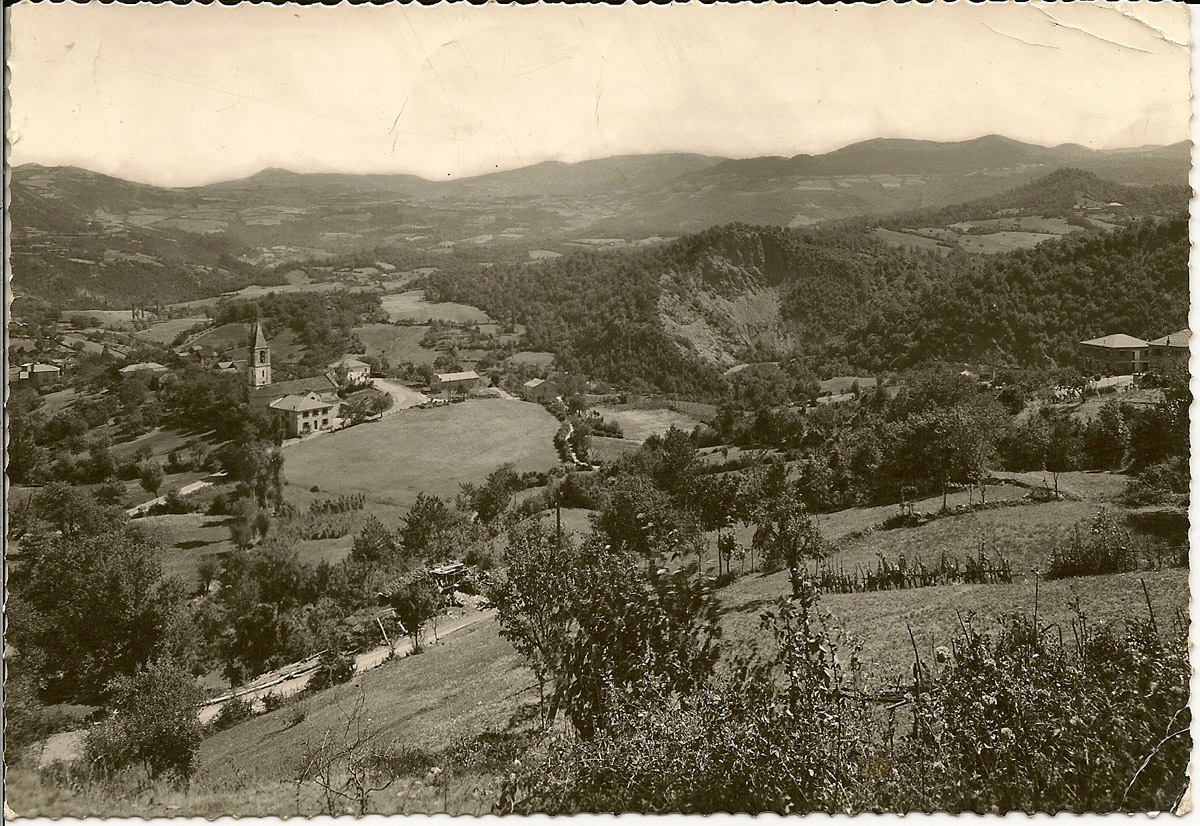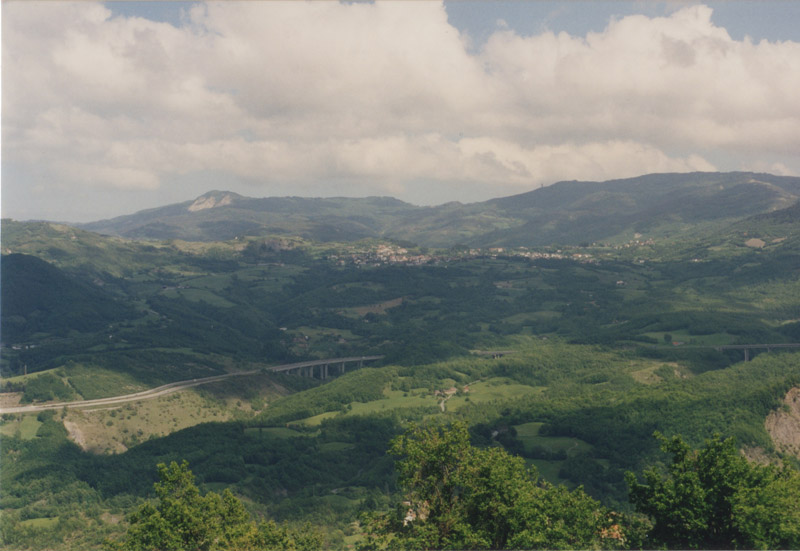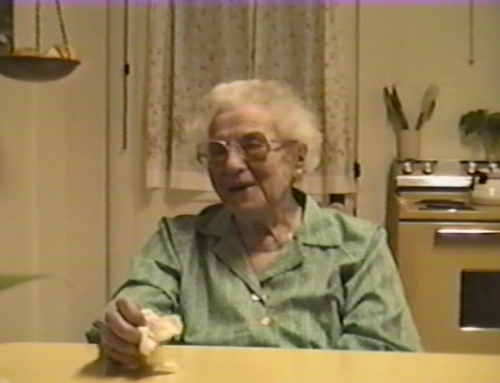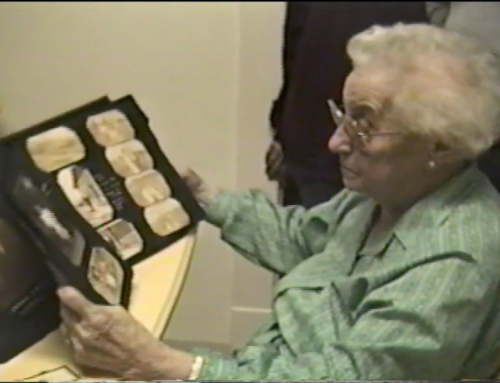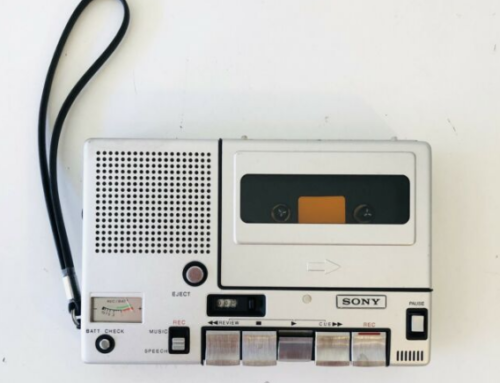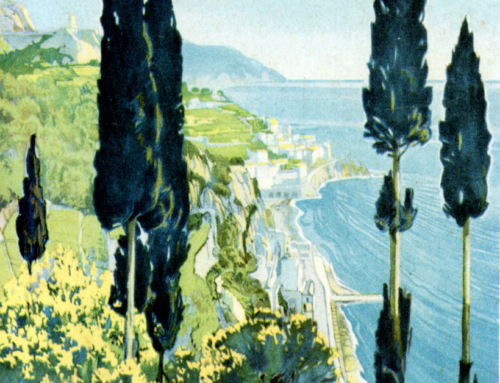While we were stationed in Naples, Italy, July 1956 to January 1958, Ralph Nevy sent this message on audio tape. It is transcribed here verbatim. There were a few names of places I couldn’t understand so spelled them as best I could. Spelling of cities is correct by my map of Italy. —Bill and Viola Orsinger
Today is November 23, 1957 and this morning we had a little snow. It didn’t lay. Now it’s clear up. Looks like we’re gonna have a nice day.
In the tape that you sent us I hear that you have the desire to go to visit the place of our birth. So I thought I’d give you an idea on this tape here how things are there and you happen to do go there you know more about it.
You start in Florence and I give you the route to Florence because I want you to stop next place, Montecatini. I’ll send you a map and you see what it is. And I want you to look that place over. I think you like it.
From there you go over to Lucca and then to Massa. At Massa you look up the mountain there you see all the marble. The mountain it’s all marble. White marble. Up in the mountain. I guess you did see it when you went through there that you went to Genoa.
From there you go to Sarzana. At Sarzana you take the Number 62. You leave the road that goes to Genoa. Go to your right. Number 62. And you go up those mountains until you get up to the top of Passo di Cisa. There you see a little church to your left and three or four houses to your right and you’ll be able to see both valleys, one side and the other one. That Passo di Cisa there used to be the border between the Duchy of Tuscany and Duchy of Parma. And the Duke of Parma owes (?) to Duke of Senott [Savoy?].
And I don’t know when but when Napoleon divorced his first wife, Maria Louisa, she was an Austrian so she went back to Austria. And the emperor of Austria, of course he, when a vacancy came and the Duke of Parma, he sent her there to take over the Duchy. And she was much better than all the dukes, the men, they had before.
First thing she did, she built that road there from where you are at Passa di Cisa, way down, straight to Parma. And that road is about oh, 175 years old. And they didn’t make any change. Just exactly like she made it at that time, as far as I know. And then she built a couple a churches, one in Parma and one in Fornovo. Fornovo is the place where the Nevy had that villa.
Now from di Cisa you go over the side of the mountain toward Berceto. As you near Berceto, if you look down the valley at a certain point in the road you can see a little church, way down in the valley, a few house around. And that’s Bergotto, the place where I was born.
And of course, I was born much way up, about half way the mountain, from the church up. I imagine you can see the little chapel that stand out on a little crop of rock there, and that chapel was the chapel from the place where I was born. The little chapel.
We used to use it too. There was about five or six families there. We used to go there and say the rosary at night in the summertime. And… a… by the way, that was built in 18… 1884, I believe. There was a disease there, cholera. And nobody could go to church and everybody built a little chapel so the priest could come and say mass and hear confessions, things like that.
Now, you are near Berceto. Before you get into Berceto there is a little small hotel to your left. And the right goes straight out to the street there but you take the road to your left and go down to the town of Berceto. And to your left, there you find an old fountain. I think you be interested to look at it. I think it about seven or eight hundred years old. Next to it is the cathedral and that’s about twelve hundred years old. You want to look at that. And next to the cathedral is the… oh, they call it the comune over there. It’s like a city hall here where they register all the people born in those valleys there, all those small towns, they register there.
Of course the church, like in the town where I was born, they register their own registration, right down in Bergotto. But the civilian registration all in there. You wanna look around that town. There is a big castle, all ruin of course. And I have one as you get into Berceto and one right inside of Berceto, right on the right there.
From Berceto… you go down… In Berceto there used to be a seminary there, used to have students for priesthood. You see that as you are coming in from di Cisa. As you go is on your left right below the Mongos [?] farm there they have. You see a big building there and a little church. I don’t know if you want to go see it or not.
After Berceto you go down and you go to La Rocca. La Rocca is a little town there next to a big rock. And you wanna stop there and up on top of the rock. You know, I live there when I was a youngster, and went back with mother. We went couple times, two or three times there and she went on top of the rock but I never did. Never saw the place. But she was just telling me the other day that there is a big… like a well, big well. You can’t see the bottom and it’s all like knife all around and they said it, they used to throw people down there when they condemned to death, they throw ‘um down there. Before they get to the bottom they are all cut up and dead. And you stop your car there and walk up. It’s not far. Go on top there and look at it. And then you have a nice view there too. See the town of Bergotto where I was born, right on your left there.
When you get through there you go down the mountain to your car, all these zig-zag very steep mountain. And the road goes back and forth, back and forth, until you get to the bottom. When you get to the bottom one road goes to the right, and those goes to the station, the railroad station of Berceto. The railroad station of Berceto is about oh 13 kilometers from Berceto. And your left your going to Borgo Taro, Borgo Val di Taro. They used to call it Borgo Taro but now they change the name and call it Borgo Val di Taro. Here what Italina was born.
Now, as you go up from there you pass an old bridge. Then you go up another two, three zig-zags. Go higher and go about half a mile and you find a road to your left there. It’s pretty hard to see it, you have to look closely. And that road there will take you to Bergotto. As you go up towards Bergotto you find a few houses here and a few houses there along the road. In fact, Bergotto, they call it Frazione di Bergotto, that means “fraction” of Bergotto, because it’s all in little fractions. You don’t have a town like other places, just a lot of fractions, from two or three houses here, two or three houses there, and three or four houses over by the church, and so on.
As you get on, close to the church, I don’t think you can go right to where the church is, but you’re pretty close then. You can stop your car there and walk over to the church. You’ll see a cemetery there, to your left. When you get to the church you go to the post office right close there and you ask the old postmaster there I’d like you to meet him. I think he’s about 80 years old now. And you talk to him. His brother have a store there near the post office that sells salt and tobacco, like all the Italian salt and tobacco stores. But I want you to meet their brother. I want you to meet the postmaster because he is a very intelligent man and you enjoy talking to him. You can ask him any question you want about the town of Bergotto, history, things like that. He might tell you a lotta things you want to know.
Then you ask him to show you where I was born. You can see it from there. You look up the mountain and you see that little chapel there. But don’t try to go up there because you’d have to have a horse or two horses, one of each. And then you’d have a hard time to get there too. And there’s nothing there anyhow. The house where I was born it’s all burn down. The fruit trees around there, the orchard, things like that.
Then you can look at the church where I was baptized, made my first communion. Then you can see the school, where I went to school. But that was burned down too but they built in the same spot. And I have relations there but they all scattered around. No use for you to gather it up, I mean to try to look.
Remember, you won’t find any place to eat there or to sleep so be prepared to get to Berceto or Borgo Taro, or Parma.
Now, when you leave Bergotto, if you want to go to Borgo Taro, it’s a nice town. It’s about 15 kilometer. But if you go to Borgo Taro you have to come back to Berceto to get to Parma. So 15 and 15 make 30. But in Borgo Taro you can see Italina’s relations and get acquainted with them. There’s a big palace there, a big palace, very old. They call ‘um Palazzo Fornovo and belongs to an old family of Parma. And they give three or four Popes to the church. And they have one palace in Rome and one in Parma. It’s still there, and you can have a look at that if you want to.
Ain’t much to see coming back but if you have the time you can do it. Otherwise you can go back to Berceto and take the road to Fornovo. That will be where we had this villa. And you see that, as you pass above Fornovo there, it’s on your right, up on a little knoll there. You ask there for Villa Mongnano or Villa Nevy. They’ll tell you where it is. And you go up there and look at the … they have the people that care of the land there, you know in Parma. You tell ‘um who you are and they’ll let you in and look at the place. And you can look it outside and see the view from there.
From there you can see a big castle way up in front of you, up on top of a mountain. Of course, you can’t go there, no road. And there is Maria Luigia College there next to the villa. And it’s a beautiful place. You’ll enjoy that.
There’s other place you could go there. You could go to Salsomaggiore. That’s another place where they [have] water and baths. Something like Montecatini. And they have a casino there, I believe. But that’s on the other side, not on the way you go to Parma. You have to go there and then come back. Come back to Parma. If you don’t go there you just go down to Parma and there you see the baptistery, the duomo, they call ‘um, cathedral and the episcopato where the bishop live, and all old buildings. In fact in the baptistery they have an organ they claim the first organ made in the world. And you see it, how it’s made. And then they have an old theater they call the “Pilotta.” You can see that. In front of have a castle outside of the city. You can visit that. I have a cousin there in Parma but I don’t know if it pays it to look him up. You can look her up, I’ll send you the address.
And is a friend of, well, it’s an uncle of Robert. He lives down about 15 miles from there. Has a place there. Is a relation of this uncle of Robert. He married the sister of a priest and they all there because he is taking care of the land and he’s taking care of the church. And you can see that. Maybe it’s the same road you be taking to Verona. I don’t know, you have to ask.
Then from there you’re going to Verona. From Verona you have to go up the town where mother was born. It’s near the lake. But she spent most of the time with her grandmother when she was a young girl and that is before you get to the lake.
As you go up from Verona you go to San Ambrogio. The road pass right close to San Ambrogio. When you in San Ambrogio you look up the mountain, is a little town up on top of the mountain they call ‘um San Giorgio. There where she spent her time, she went to school there too. Then you can go to the lake or go to Caprino Veronese, the town where she was born.
But you’ll enjoy to go around the lake. You go up on your right side, go to Prada and you go up a little bit and you find a place called San Varenna. It’s a history place but I don’t know the history. You should have a book that tells you all those things. And up above you find a big castle and that’s the castle of Charlemagne, the big emperor, Charlemagne. And you can leave that and go to Riva. And from Riva you go down the other side, along those rocky road, nice road in the rock and you go down to… oh different town you pass there, beautiful view. And you go down to Gardone. There’s a little island in the middle of the lake with a big castle. And find out if you can go over there and visit that.
Then below is a big tower. That’s where they put all the bones of the battle they had in Austria in 24 June 1859. Napoleon came down and helped the Italians chase the Austrians away from Italy. Quite a great battle there. A lotta soldiers got killed so they made a monument, a high monument and they bury all the bones, right there in this monument. That’ll be interesting to see too.
From there you can go back through Verona, Padua and pass through the town where Pope Pius X was born and you can go to Venezia. And of course you know what of Venezia. A nice place to see, and spend some time there.

